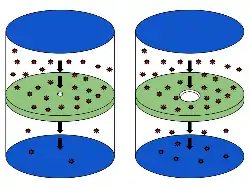Effusion
In physics and chemistry, effusion is the process in which a gas escapes from a container through a hole of diameter considerably smaller than the mean free path of the molecules.[1] Such a hole is often described as a pinhole and the escape of the gas is due to the pressure difference between the container and the exterior. Under these conditions, essentially all molecules which arrive at the hole continue and pass through the hole, since collisions between molecules in the region of the hole are negligible. Conversely, when the diameter is larger than the mean free path of the gas, flow obeys the Sampson flow law.

In medical terminology, an effusion refers to accumulation of fluid in an anatomic space, usually without loculation. Specific examples include subdural, mastoid, pericardial and pleural effusions.
Effusion into vacuum
Effusion from an equilibrated container into outside vacuum can be calculated based on kinetic theory.[2] The number of atomic or molecular collisions with a wall of a container per unit area per unit time (impingement rate) is given by:
If a small area on the container is punched to become a small hole, the effusive flow rate will be
where is the molar mass. Note that the outside vacuum has zero pressure, so the pressure difference between two sides of the hole is simply .
The average velocity of effused particles is
Combined with the effusive flow rate, the recoil/thrust force on the system itself is
An example is the recoil force on a balloon with a small hole flying in vacuum.
Measures of flow rate
According to the kinetic theory of gases, the kinetic energy for a gas at a temperature is
where is the mass of one molecule, is the root-mean-square speed of the molecules, and is the Boltzmann constant. The average molecular speed can be calculated from the Maxwell speed distribution as (or, equivalently, ). The rate at which a gas of molar mass effuses (typically expressed as the number of molecules passing through the hole per second) is then[3]
Here is the gas pressure difference across the barrier, is the area of the hole, is the Avogadro constant, is the gas constant and is the absolute temperature. Assuming the pressure difference between the two sides of the barrier is much smaller than , the average absolute pressure in the system (i.e. ), it is possible to express effusion flow as a volumetric flow rate as follows:
or
where is the volumetric flow rate of the gas, is the average pressure on either side of the orifice, and is the hole diameter.
Effect of molecular weight
At constant pressure and temperature, the root-mean-square speed and therefore the effusion rate are inversely proportional to the square root of the molecular weight. Gases with a lower molecular weight effuse more rapidly than gases with a higher molecular weight, so that the number of lighter molecules passing through the hole per unit time is greater. This is why a balloon filled with low molecular weight helium (M = 4) deflates faster than an equivalent balloon full of higher molecular weight oxygen (M = 32). However the total mass of the escaping molecules is directly proportional to the square root of the molecular weight and is less for lighter molecules.
Graham's law
Scottish chemist Thomas Graham (1805–1869) found experimentally that the rate of effusion of a gas is inversely proportional to the square root of the mass of its particles.[4] In other words, the ratio of the rates of effusion of two gases at the same temperature and pressure is given by the inverse ratio of the square roots of the masses of the gas particles.
where and represent the molar masses of the gases. This equation is known as Graham's law of effusion.
The effusion rate for a gas depends directly on the average velocity of its particles. Thus, the faster the gas particles are moving, the more likely they are to pass through the effusion orifice.
Knudsen effusion cell
The Knudsen effusion cell is used to measure the vapor pressures of a solid with very low vapor pressure. Such a solid forms a vapor at low pressure by sublimation. The vapor slowly effuses through a pinhole, and the loss of mass is proportional to the vapor pressure and can be used to determine this pressure.[3] The heat of sublimation can also be determined by measuring the vapor pressure as a function of temperature, using the Clausius–Clapeyron relation.[5]
References
- K.J. Laidler and J.H. Meiser, Physical Chemistry, Benjamin/Cummings 1982, p.18. ISBN 0-8053-5682-7
- "5.62 Physical Chemistry II" (PDF). MIT OpenCourseWare.
- Peter Atkins and Julio de Paula, Physical Chemistry (8th ed., W.H.Freeman 2006) p.756 ISBN 0-7167-8759-8
- Zumdahl, Steven S. (2008). Chemical Principles. Boston: Houghton Mifflin Harcourt Publishing Company. p. 164. ISBN 978-0-547-19626-8.
- Drago, R.S. Physical Methods in Chemistry (W.B.Saunders 1977) p.563 ISBN 0-7216-3184-3